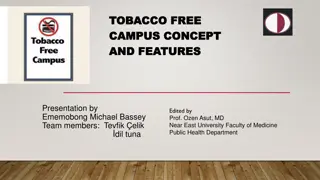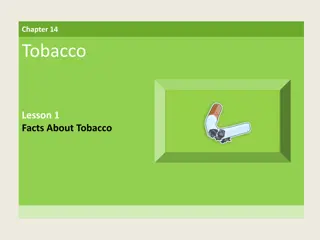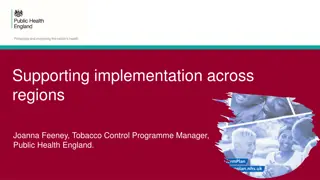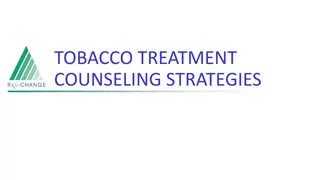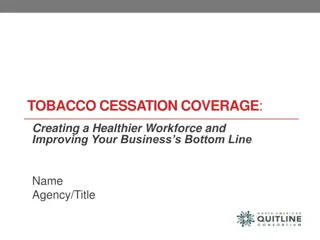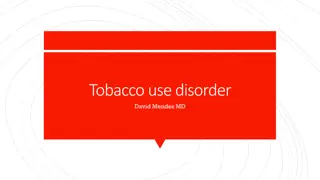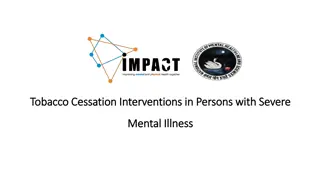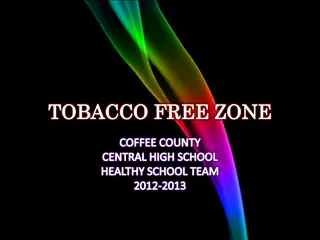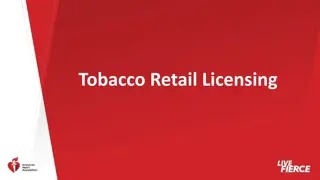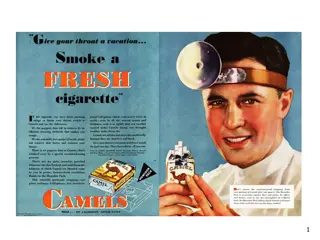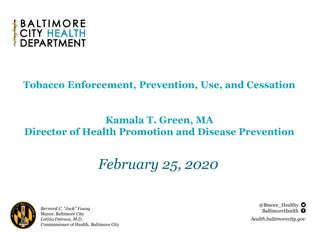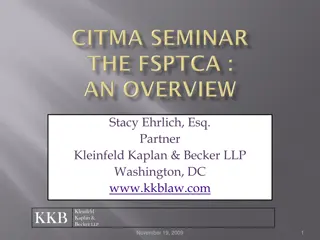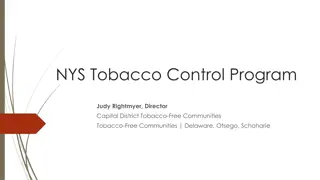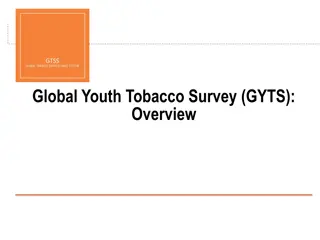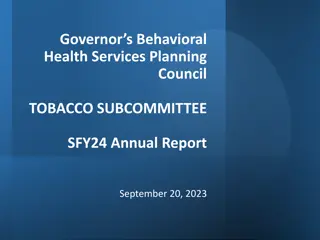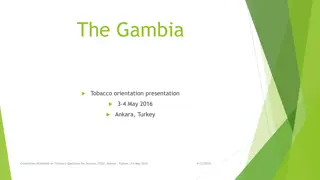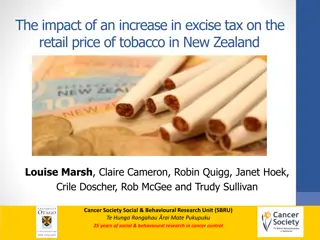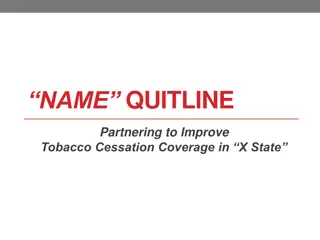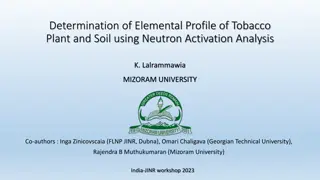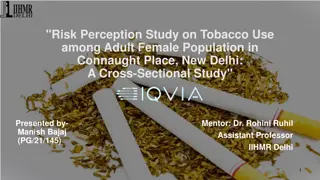Comprehensive Tobacco Recovery & Wellness Initiative: Behavioral Interventions
This initiative focuses on promoting culture change by advancing an integrated recovery-oriented tobacco intervention through practical counseling methods. Topics include adapting evidence-based counseling protocols, identifying appropriate methods based on client readiness, and implementing tobacco awareness strategies. The program emphasizes cultural adaptation, surface, and deep structure considerations to effectively engage clients. Recovery slogans provide encouragement and support throughout the intervention process.
Download Presentation

Please find below an Image/Link to download the presentation.
The content on the website is provided AS IS for your information and personal use only. It may not be sold, licensed, or shared on other websites without obtaining consent from the author. Download presentation by click this link. If you encounter any issues during the download, it is possible that the publisher has removed the file from their server.
E N D
Presentation Transcript
Community Behavioral Health Tobacco Recovery & Wellness Initiative Behavioral Interventions: Tobacco Awareness Tony Klein, MPA, NCACII Tony.Klein@rochesterregional.org
DISCUSSION Client Engagement Strategy Promoting Culture Change Advancing an Integrated Recovery- Oriented Tobacco Intervention Practical Counseling Methods
LEARNING OBJECTIVES Participants will: Learn to adapt evidence-based tobacco counseling protocols to a recovery-oriented culture Identify 2 counseling methods to ensure that the intervention is appropriate to client stage readiness Describe 5 Tobacco Awareness topics designed to advance client stage readiness
Tobacco use is a social and cultural problem with an individual addictive component. Bauer, 2006 Working Copy
Embrace Recovery! Be Physically and Emotionally Healthy . Be Alcohol, Tobacco & Drug-Free
CULTURAL ADAPTATION Goal: To accommodate the cultural beliefs, values, attitudes, and behaviors of the target population Modify Evidence-Based Treatment Design Treatment components Approach to delivery Nature of the therapeutic relationship Take into account: Historical, Environmental & Social Forces Hawkins, Kreuter et al., 2008
SURFACE & DEEP STRUCTURE Surface Structure: match intervention materials and messages to observable social and behavioral characteristics. Deep Structure: incorporate the core cultural values of the target group to increase saliency of the message and program impact. Changes in both facilitate participants experience of self-reference and identification with the message, which increases the likelihood that they will identify discrepancies between their actual and ideal behaviors. Resnicow et al., 2000
RECOVERY SLOGANS We ll love you, until you learn to love yourself Courage to change You can t think you way into sober living; you have to live your way into sober thinking It s easy to talk the talk, but you have to walk the walk Try it your 90 days, and if you don t like it, we ll gladly refund your misery Today I have more solutions than problems We give it away to keep it Be part of the solution, not the problem Easy does it First things first This, too, shall pass One day at a time Keep coming back It works if you work it Just for today Pass it on Let it begin with me Practice an attitude of gratitude You are not alone Share your happiness Share your pain Respect the anonymity of others
CULTURAL ADAPTATION PROCESS Change in Surface & Deep Structure PHASE I: PHASE II: PHASE III: PHASE IV: Data Collection Treatment Modification Pilot Test Outcomes Acceptability Social validity Feasibility Satisfaction Comprehension Credibility Self-Reference Therapeutic Alliance Preliminary Efficacy Treatment Entry Treatment Attendance Therapeutic Alliance Treatment Adherence Treatment Response Maintenance of Treatment Response Quantitative Data Qualitative Data Community Based Participatory Research Methods Community Advisory Board Develop Culturally Appropriate and Valid Measures Ensure Health Literacy of Materials Cultural Translation if Needed Treatment Content Treatment Modality Treatment Intensity Treatment Delivery Borrelli, B. (2010). Smoking Cessation: Next Steps for Special Populations Research and Innovative Treatments. Journal of Consulting and Clinical Psychology, 78(1), 1-12.
REFRAME LANGUAGE Use language consistent to recovery culture, 12-Step teachings and therapeutic community principles Public Health/Medical Terms Preferred Terminology Smoking Quit Date Cessation Tobacco Use, Hit, Fix Recovery Start Date Tobacco Treatment, Recovery The language we use is fundamental in creating environments conducive to a recovery process. William White
SELF-DETERMINATION THEORY Deci & Ryan, 1985 Three Psychological Needs: Autonomy freedom to choose Self-Efficacy an inner sense of competence Relatedness a connectedness to others when self-determined, people experience a sense of freedom to do what is interesting, personally important, and vitalizing. www.psych.rochester.edu/SDT/theory.html
STAGESOF READINESSTO CHANGE Prochaska & DiClemente Transtheoretical Model, 1983
STAGESOF READINESSTO CHANGE Precontemplation: The individual does not expect to make any change in behavior within the next 6 months. At this stage, the individual is resistant to hearing or learning about health behavior change. Contemplation: The individual plans to make a behavior change within the next 6 months. This stage is characterized by ambivalence about smoking. Preparation: The individual anticipates making a behavior change within the next month. Individuals in this phase have made plans for taking action and intend to make a change. Action: The individual has made a significant change; this means that the individual has quit completely. Maintenance: The individual attempts to prevent relapse. Prochaska & DiClemente Transtheoretical Model, 1983
READINESSTO CHANGE BEHAVIOR IMPORTANCE (Knowledge) READINESS CONFIDENCE (Skills)
TOBACCO INTERVENTIONS Two Levels of Behavioral Counseling to Match Intervention to Client Stage-Readiness: Tobacco Recovery Behavioral Learn Coping Skills Elevate Confidence Embrace Lifestyle Change Always with Pharmacotherapy Tobacco Awareness Cognitive) Engagement Develop Interest Highlight Importance Advance Stage-Readiness
TOBACCO AWARENESS FACILITATION 40% When to Use MI 40% 20% When to Use CBT (Tobacco Recovery Counseling) Norcross, J.C. Psychotherapy Relationships That Work, Seymour Fisher Memorial Workshop, State University of New York Upstate Medical Center, October 2005
TOBACCO AWARENESS FACILITATION Matching Counselor Role to Stage Readiness Stage Readiness Pre-contemplation Role Nurturing Parent Objective recognize problem behavior develop willingness to change acquire skills Contemplation Socratic Teacher Preparation/Action Experienced Coach Maintenance Trusted Consultant prevent relapse Norcross, J.C. Psychotherapy Relationships That Work, Seymour Fisher Memorial Workshop, State University of New York Upstate Medical Center, October 2005
TOBACCO AWARENESS FACILITATION Goals Methods Promote insight into tobacco use behavior Identify correlation to AOD Express a recovery-oriented message Promote ambivalence Elicit change talk Motivational Interviewing Narrative Therapy Psychoeducation (foster teachable moments)
TOBACCO AWARENESS FACILITATION The more change talk that clients demonstrate, the more likely it is that they will move towards making a change Change Status Quo
MOTIVATIONAL INTERVIEWING Motivational Interviewing was developed from the rather simple notion that the way clients are spoken to about changing addictive behavior affects their willingness to talk freely about why and how they might change. Stephen Rollnick, Addiction 2001; 96:1769-70 Motivational that works on facilitating and engaging intrinsic motivation within the client in order to change behavior. MI is a goal-oriented, client-centered counseling style for eliciting behavior change by helping clients to explore and resolve ambivalence. www.motivationalinterviewing.org
MOTIVATIONAL INTERVIEWING 5 Principles of MI MI Skill Basic MI Method OARS Express empathy Develop discrepancy Avoid argumentation Roll with resistance Support self-efficacy Reflective Listening & Thinking Asking Clarifying Questions Resolving Ambivalence Enhancing Self-Motivational Statements Open-ended Questions Affirm Strengths Reflective Listening Summarize MI in Practice Building Motivation Talk less than your client Most common response should be a reflection Ask mostly open-ended questions Most Important Avoid getting ahead of your client s stage readiness Ask permission Listen Reflectively Affirm and Support Raise Concern Elicit Self-Motivational Statements Summarize www.motivationalinterviewing.org
WHAT DOESA GREAT FACILITATOR DO? avoids taking sides (neutral position) demonstrates confidence and honesty (authenticity) is aware of the group mood and behavior of individuals demonstrates active and reflective listening asks questions that encourages client self-disclosure promotes peer to peer dialogue has a sense of humor can tolerate conflict within the group can summarize the discussion simply
SUGGESTED FACILITATOR TOPICS The traditional use of tobacco use in the recovering community, i.e. coffee and cigarettes at 12-Step Meetings Share information on how cigarettes have been re-engineered to make them more addicting Highlight and thoroughly explore the role that tobacco plays within alcohol and drug use rituals Acknowledge how tobacco use may increase the potential for alcohol/drug relapse Conduct a group decisional balance exercise Elicit client experiences on emotional detachment
TOBACCO AWARENESS FACILITATION FUNDAMENTALCLINICALOBJECTIVES Create a safe therapeutic environment to set the tone and direction of the discussion Approach the topic from the clients perspective, experiences, existing knowledge of chemical dependency and drug recovery Foster teachable moments Establish a group consensus Clearly summarize key points of the discussion
TOBACCO AWARENESS FACILITATION To create a safe therapeutic environment to set the tone and direction of the discussion A client-centered approach to support autonomous motivation Set the Stage - provide a brief overview of the topic of discussion Emphasize to the group that their verbal contribution is valuable Ask the group for their permission to explore the topic
TOBACCO AWARENESS FACILITATION Sample Dialogue Setting The Stage Good morning everyone. Today, I d like to explore some aspects of addiction and recovery that may be new to some of us. What you do with this information is totally up to you; nonetheless, it will be interesting to see if any of us can relate to the topic from personal experiences. So with your help, I d like explore how tobacco use may be a part of the use ritual of other substances. Does anyone in this room hit on a cigarette or a cigar while drinking or getting high? Is tobacco a part of your drug use ritual? [Ask for a show of raised hands and wait for a response.] I believe that you ll find this discussion helpful and I d like to share some current research on the topic. Is it OK to talk about this?
TOBACCO AWARENESS FACILITATION To increase tobacco awareness by approaching the topic from the clients perspective, experiences, existing knowledge of chemical dependency and drug recovery So let s start by seeing if there is a connection for some of us to alcohol. When you re drinking, is a cigarette a part of the picture? Would anyone like to share your experiences? As clients disclose their personal experiences, use reflective listening responses and summarizing as much as possible. The objective is to sustain and enrich the dialogue keeping the center of attention on the clients, not turn the session into a question and answer process. After thoroughly exploring the associations of tobacco to alcohol, give equal time to marijuana, heroin, cocaine, etc.
TOBACCO AWARENESS FACILITATION As clients verbally contribute to the session, explore the following: Was it sometimes or always a part of your use ritual? Would you hit on the cigarette before, during, or after hitting on the blunt? So it sounds like a cigarette was a major player in your drug use ritual. Can you explain why it was so important? What did it do for you that made it so important? The cigar would affect your high. Can you say more what do you mean? What would you do if you had a bag of dope, but didn t have a cigarette? Typically, you will experience a session with most clients acknowledging that tobacco use is central to their drug use ritual and indicative of addict thinking, feeling and behavior. As those conclusions are shared, it s helpful to amplify and inject humor into your reflective responses, keep the dialogue flowing, maintain the emotional energy, and repeatedly summarize client disclosure to reinforce the key points being shared.
REFLECTIVE LISTENING Simple, Amplified and Double-Sided Reflection I always need to smoke a cigarette when I m getting high. I go through a whole pack when drinking or drugging and totally panic when I m down to my last cigarette or run out. Content Reflection There is a strong association between your drug of choice and tobacco use. Feeling Reflection You get anxious when you run out of cigarettes. Meaning Reflection (12-Step Reference, Amplified) So it sounds like you re powerless over tobacco.
FINAL THOUGHTS JUMPONIN, THEWATERISFINE! The more often you facilitate a tobacco awareness session: the more narratives you will hear and can reference in future sessions the better you become in being able to reframe language for greatest impact the more will learn about the topic from a street perspective the more depth to client disclosure will be presented Don t be afraid to say I don t know, I ll look into it! Have fun!




